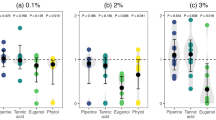Abstract
The chemical basis underlying orientation to fruit and fungal odors was investigated for the dried-fruit beetle,Carpophilus hemipterus (L.). In wind-tunnel bioassays of walking and flight response from 1.8 m, beetles were attracted to odors of the yeastSaccharomyces cerevisiae on agar, aseptic banana, or banana inoculated withS. cerevisiae, although both banana substrates elicited greater response than the yeast alone. When presented in a two-choice bioassay, the yeast-inoculated banana attracted approximately twice as many beetles as did the aseptic banana. GC-MS analysis of the headspace volatiles above these odor sources revealed a somewhat more complex and concentrated volatile profile for yeast-inoculated banana than for aseptic banana. The odor from yeast on agar had fewer components, and these were present at lower concentrations than the odors of either banana substrate. By blending mineral-oil or aqueous solutions of the 18 components of inoculated-banana odor in varying concentrations, it was possible to mimic closely the headspace profile of the natural odor. This synthetic odor also elicited beetle attraction in the wind tunnel at levels comparable to the inoculated banana. Through a series of bioassays in which individual components were subtracted from or added to a synthetic odor blend, it was determined that ethyl acetate, acetaldehyde, 2-pentanol, and 3-methylbutanol comprised the simplest blend of compounds evoking full behavioral response. However, 2-methylpropanol or butanol were apparently interchangeable with 3-methylbutanol in this blend, and comparable response could also be elicited by replacing acetaldehyde with a combination of both 2-pentanone and 3-hydroxy-2-butanone. Thus, our results suggest that this generalist insect herbivore locates its hosts by a long-range response to a variety of blends of common fruit volatiles, whose concentrations are enhanced by fungi.
Similar content being viewed by others
References
Alm, S.R., Hall, F.R., McGovern, T.P., andWilliams, R.N. 1986. Attraction ofGlischrochilus quadrisignatus (Coleoptera: Nitidulidae) to semiochemicals: Butyl acetate and propyl propionate.J. Econ. Entomol. 79:654–658.
Bartelt, R.J., Dowd, P.F., Plattner, R.D., andWeisleder, D. 1990. Aggregation pheromone of driedfruit beetle,Carpophilus hemipterus: Wind-tunnel bioassay and identification of two novel tetraene hydrocarbons.J. Chem. Ecol. 16:1015–1039.
Blackmer, J.L., andPhelan, P.L. 1991. Effect of physiological state and fungal inoculation on chemically modulated host-plant finding byCarpophilus hemipterus andCarpophilus lugubris. Entomol. Exp. Appl. In press.
Caldis, P.D. 1930. Souring of the figs by yeasts and the transmission of the disease by insects.J. Agric. Res. 40:1031–1051.
Dindonis, L.L., andMiller, J.R. 1981. Onion fly and little house fly host finding selectively mediated by decomposing onion and microbial volatiles.J. Chem. Ecol. 7:421–428.
Finch, S., andSkinner, G. 1982. Trapping cabbage root flies in traps baited with plant extracts and with natural and synthetic isothiocyanates.Entomol. Exp. Appl. 31:133–139.
Foott, W.H., andTimmins, P.R. 1977. Biology ofGlischrochilus quadrisignatus (Coleoptera: Nitidulidae) in southwestern Ontario.Proc. Entomol. Soc. Ont. 108:37–44.
Hall, R.W., Smilanick, J.M., andEhler, L.E. 1978. Laboratory rearing and field observation onCarpophilus mutilatus.Ann. Entomol. Soc, Am. 71:408–410.
Hinton, H.E. 1945. A Monograph of the Beetles Associated with Stored Products. Jarrold and Sons, Norwich, UK. 443 pp.
Honda, H., Ishiwatari, T., andMatsumoto, Y. 1988. Fungal volatiles as ovipositional attractants for the yellow peach moth,Conogethes punctiferalis (Guenée) (Lepidoptera: Pyralidae).J. Insect Physiol. 34:205–211.
Jermy, T. 1988. Can predation lead to narrow food specialization in phytophagous insects?Ecology 69:902–904.
Lance, D.R. 1983. Host-seeking behavior of the gypsy moth: The influence of polyphagy and highly apparent host plants, pp. 201–224,in S. Ahmad (ed.). Herbivorous Insects. Academic Press, New York.
Lin, H., andPhelan, P.L. 1991. Identification of food volatiles attractive to the dusky sap beetle,Carpophilus lugubris (Coleoptera: Nitidulidae).J. Chem. Ecol. In press.
Lindgren, D.L., andVincent, L.E. 1953. Nitidulid beetles infesting California dates.Hilgardia 22:97–118.
Maarse, H., andVisscher, C.A. 1988. Volatile Compounds in Food: Quantitative Data, Vol. 7. TNO-CNO Food Analysis Institute, Zeist, The Netherlands.
May, M.L., andAhmad, S. 1983. Host location in the Colorado potato beetle: searching mechanisms in relation to oligophagy, pp. 173–199,in S. Ahmad (ed.). Herbivorous Insects. Academic Press, New York.
Miller, J.R., andStrickler, K.L. 1984. Finding and accepting host plants, pp. 127–157in W.J. Bell and R.T. Cardé (eds.). Chemical Ecology of Insects. Chapman and Hall, London.
Miller, M.W., andMrak, E.M. 1953. Yeasts associated with dried-fruit beetles in figs.Appl. Microbiol. 1:174–178.
Phelan, P.L., Roelofs, C.J., Youngman, R.R., andBaker, T.C. 1991. Characterization of chemicals mediating ovipositional host-plant finding byAmyelois transitella females.J. Chem. Ecol. 17:599–613.
SAS Institute. 1985. SAS User's Guide: Statistics. SAS Institute, Cary, North Carolina.
Schreier, P. 1984. Chromatographic Studies of Biogenesis of Plant Volatiles. Hüthig, New York. 171 pp.
Smilanick, J.M., Ehler, L.E., andBirch, M.C. 1978. Attraction ofCarpophilus spp. (Coleoptera: Nitidulidae) to volatile compounds present in figs.J. Chem. Ecol. 4:701–707.
Tate, K.G., andOgawa, J.M. 1975. Nitidulid beetles as vectors ofMonilinia fructicola in California stone fruits.Phytopathology 65:977–983.
Visser, J.H. 1986. Host odor perception in phytophagous insects.Annu. Rev. Entomol. 31:121–144.
Wildman, J.D. 1933. Note on the use of microorganisms for the production of odors attractive to the dried fruit beetle.J. Econ. Entomol. 26:516–517.
Author information
Authors and Affiliations
Rights and permissions
About this article
Cite this article
Phelan, P.L., Lin, H. Chemical characterization of fruit and fungal volatiles attractive to dried-fruit beetle,Carpophilus hemipterus (L.) (Coleoptera: Nitidulidae). J Chem Ecol 17, 1253–1272 (1991). https://doi.org/10.1007/BF01402948
Received:
Accepted:
Issue Date:
DOI: https://doi.org/10.1007/BF01402948




